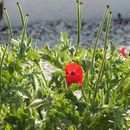Distribution in Egypt
provided by Bibliotheca Alexandrina LifeDesk
Nile region (Cairo region), Mediterranean region and Sinai.
- author
- BA Cultnat
- provider
- Bibliotheca Alexandrina
Global Distribution
provided by Bibliotheca Alexandrina LifeDesk
Bulgharia, Romania, Caucasia, Iran, Mediterranean region, Sinai, Arabia, north Iraq.
- author
- BA Cultnat
- provider
- Bibliotheca Alexandrina
Habitat
provided by Bibliotheca Alexandrina LifeDesk
- author
- BA Cultnat
- provider
- Bibliotheca Alexandrina
Life Expectancy
provided by Bibliotheca Alexandrina LifeDesk
- author
- BA Cultnat
- provider
- Bibliotheca Alexandrina
Comments
provided by eFloras
Glaucium corniculatum has been widely introduced outside its native Eurasian range as a crop weed and ballast waif. It can persist in a fairly broad range of climates and probably is established in North America more widely than existing herbarium records indicate.
- license
- cc-by-nc-sa-3.0
- copyright
- Missouri Botanical Garden, 4344 Shaw Boulevard, St. Louis, MO, 63110 USA
Description
provided by eFloras
Plants annual or occasionally biennial, to 5 dm. Stems branching. Leaves to 25 cm; basal few, blade glabrate to moderately pubescent; basal and proximal cauline with blade lyrate, 7-9-lobed; distal with blade ovate, not distinctly clasping stem (sometimes slightly cordate-clasping); margins deeply dentate. Flowers: pedicels stout, to 5 cm; sepals 15-30 mm; petals orange to reddish orange, usually with blackish basal spot, obovate, to 40 mm. Capsules sublinear, straight or slightly curved, to 25 cm, appressed- to ascending-pubescent or glabrate.
- license
- cc-by-nc-sa-3.0
- copyright
- Missouri Botanical Garden, 4344 Shaw Boulevard, St. Louis, MO, 63110 USA
Distribution
provided by eFloras
introduced; Kans., Mont., Nev., N.Y., Oreg., Pa., Tex.; Europe; sw Asia.
- license
- cc-by-nc-sa-3.0
- copyright
- Missouri Botanical Garden, 4344 Shaw Boulevard, St. Louis, MO, 63110 USA
Flowering/Fruiting
provided by eFloras
Flowering late spring-summer.
- license
- cc-by-nc-sa-3.0
- copyright
- Missouri Botanical Garden, 4344 Shaw Boulevard, St. Louis, MO, 63110 USA
Habitat
provided by eFloras
Open shores, fields, pastures, and canyon slopes; 0-1600m.
- license
- cc-by-nc-sa-3.0
- copyright
- Missouri Botanical Garden, 4344 Shaw Boulevard, St. Louis, MO, 63110 USA
Synonym
provided by eFloras
Chelidonium corniculatum Linnaeus, Sp. Pl. 1: 506. 1753
- license
- cc-by-nc-sa-3.0
- copyright
- Missouri Botanical Garden, 4344 Shaw Boulevard, St. Louis, MO, 63110 USA
Glaucium corniculatum
provided by wikipedia EN
Glaucium corniculatum, the blackspot hornpoppy[2] or red horned-poppy,[3] is a species of the genus Glaucium in the poppy family (Papaveraceae). It is an annual flowering plant, occurring in southern Europe, and grows up to 1 foot (30 cm) high. The stem and leaves are hairy, the capsule fruit is covered with stiff hair, the flower is red, with a black spot on the base of the tepal bract, which has a yellow margin around it. The flower appears from June until August.
References

- license
- cc-by-sa-3.0
- copyright
- Wikipedia authors and editors
Glaucium corniculatum: Brief Summary
provided by wikipedia EN
Glaucium corniculatum, the blackspot hornpoppy or red horned-poppy, is a species of the genus Glaucium in the poppy family (Papaveraceae). It is an annual flowering plant, occurring in southern Europe, and grows up to 1 foot (30 cm) high. The stem and leaves are hairy, the capsule fruit is covered with stiff hair, the flower is red, with a black spot on the base of the tepal bract, which has a yellow margin around it. The flower appears from June until August.
- license
- cc-by-sa-3.0
- copyright
- Wikipedia authors and editors

